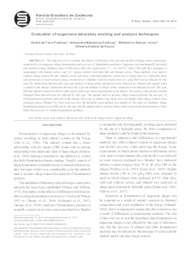Evaluation of sugarcane laboratory ensiling and analysis techniques.
Evaluation of sugarcane laboratory ensiling and analysis techniques.
Author(s): PEDROSO, A. de F.; PEDROSO, A. M.; BARIONI JUNIOR, W.; SOUZA, G. B. de
Summary: The objective was to evaluate the effects of laboratory-silo type and method of silage extract production, respectively, on sugarcane silage fermentation and recovery of fermentation products. Sugarcane was mechanically harvested and ensiled in three different types of laboratory silos (five replicates): 9.7 × 30 cm PVC tubes with tight lids, equipped or unequipped with Bunsen valves, and 20 L plastic buckets with tight lids and Bunsen valves. Three methods were used to produce silage extracts for pH, ethanol, acetic and lactic acids determination: extraction of silage juice by a hydraulic press and production of water extracts using a stomacher or a blender. Total dry matter loss (231 g/kg DM) was not affected by silo type. No interactions between silo type and method of silage extract production were observed for ethanol and organic acids contents in the silages. Interaction between silo type and method of silage extract preparation was detected for pH. Silo type affected ethanol content but did not affect lactic and acetic acids concentration in the silages. Dry matter, crude protein, neutral detergent fiber and ash were not affected by silo type. The method used to produce silage extracts affected the recovery of all fermentation products analyzed in the silages. Recovery of ethanol and acetic acid was higher when silage extracts were produced using a blender. For lactic acid recovery, the hydraulic press method was superior to the other two methods. Silage fermentation pattern is not affected by silo type, but the method used to produce silage extracts and some characteristics of silos affect the recovery of volatile fermentation products.
Publication year: 2014
Types of publication: Journal article
Keywords: Ethanolc, Laboratory silo, Silage extract, Sugarcane silage, acetic acid, lactic acid
Observation
Some of Embrapa's publications are published as ePub files. To read them, use or download one of the following free software options to your computer or mobile device. Android: Google Play Books; IOS: iBooks; Windows and Linux: Calibre.
Access other publications
Access the Agricultural Research Database (BDPA) to consult Embrapa's full library collection and records.
Visit Embrapa Bookstore to purchase books and other publications sold by Embrapa.

